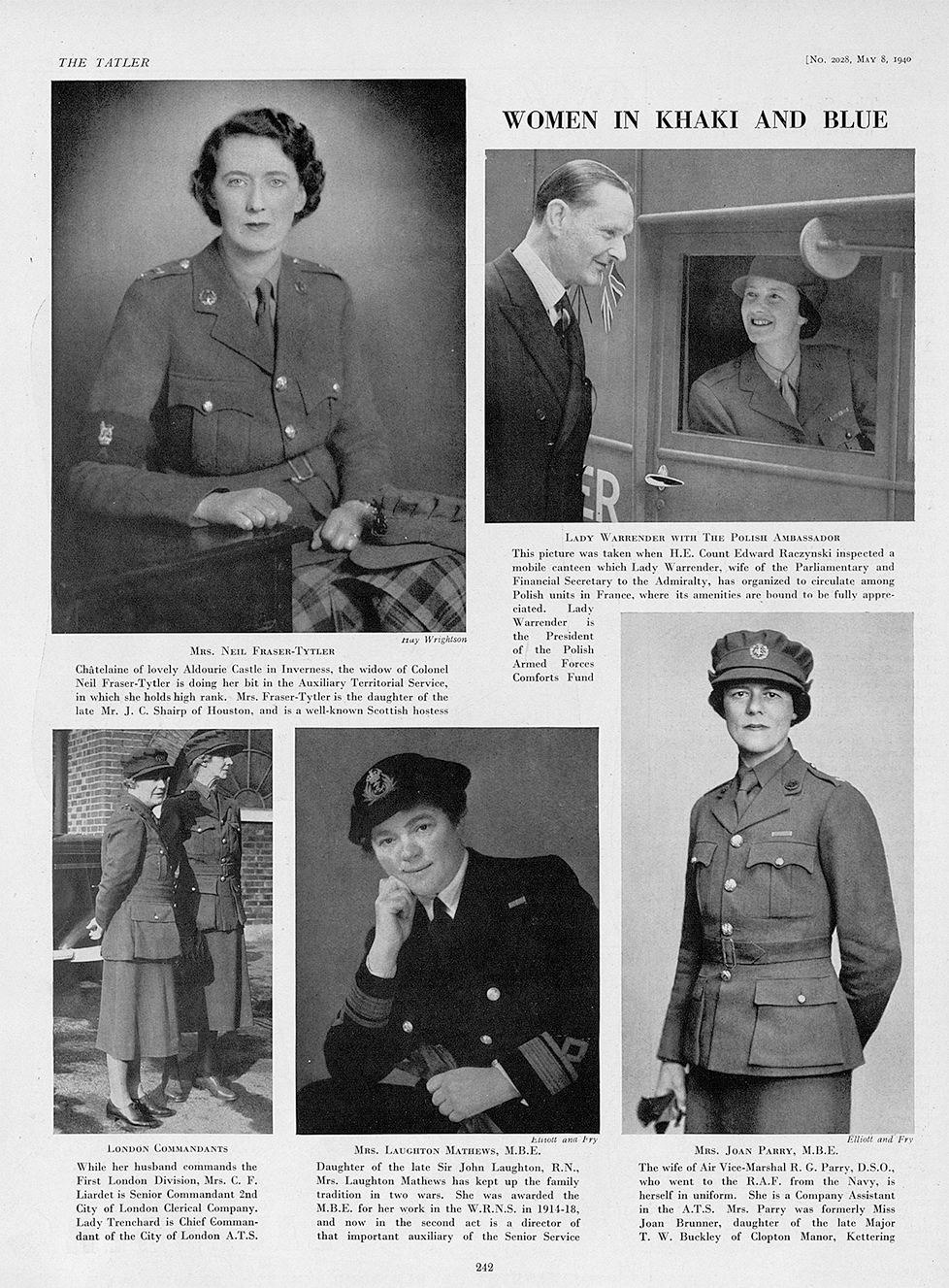During the Second World War, British women were encouraged to take up industrial, military, and civil roles. This significant social trend was reflected in contemporary news and reporting—women at work, rarely at play, and women in uniform was the order of the day. Utilising photo journalism, popular publications, such as The Tatler (which merged with it sister publication, The Bystander, in 1940, thus becoming The Tatler and Bystander) placed women’s impact at the heart of their coverage.
For example, on 8 May 1940, The Tatler published a piece titled “Women in Khaki and Blue”. This supplied readers with a series of photographs of senior female figures in service.
In the feature, Lady Warrender, president of The Polish Armed Forces Comforts Fund is pictured with the Polish Ambassador, His Excellency Count Edward Raczynksy. He is inspecting a mobile canteen which Lady Warrender had organised to circulate among Polish units in France where, as the author of the piece noted, “it’s amenities are bound to be fully appreciated”.
A holder of high rank in the Auxiliary Territorial Service (ATS), Mrs Neil Fraser-Tytler, is also pictured in her ATS jacket and tartan skirt in a seated studio shot. Mrs Fraser-Tytler, of Aldourie Castle in Inverness, was the widow of Colonel Neil Fraser and a well-known Scottish hostess.
Two London commandants are likewise pictured on duty in the city. Mrs C. F. Liardet, Senior Commandant, 2nd City of London Clerical Company, stands alongside Lady Trenchard, Chief Commandant of the City of London ATS. They are alert in the sunshine in this outdoor scene.
Mrs Laughton Mathews, MBE, was praised for having “kept up the family tradition in two wars”. Her MBE was awarded in recognition of her service in the Women's Royal Naval Service (WRNS) during the First World War. By 1940, she was the director of “that important auxiliary of the Senior Service”. Mathews is shown in her uniform and cap in a casual studio portrait.
With a strong direct to camera gaze, the wife of Air Vice-Marshal R. G. Parry, DSO, Mrs Joan Parry, is pictured in her ATS uniform. Having gained an MBE for her service, she had progressed from the Navy to the RAF prior to taking up her role as Company Assistant in the ATS.
Photographers for the article included Ray Wrightson, Elliot and Fry.
Carefully placed on the next page was a full-page advertisement for Burberry. This luxury British fashion brand supplied uniforms and equipment to the ATS during the war. The ad shows a woman wearing uniform and gloves, as she pauses to retrieve items from her wallet. She is leaning against her vehicle beside a building on a military base. The ad highlights Burberry’s use of “the best quality materials” that were “skillfully tailored”. The ad also emphasised how Burberry’s clothing was the “embodiment of perfection” and provided “weather security”. Importantly, the ad also conveys the suitability of such clothing for women serving in the military.
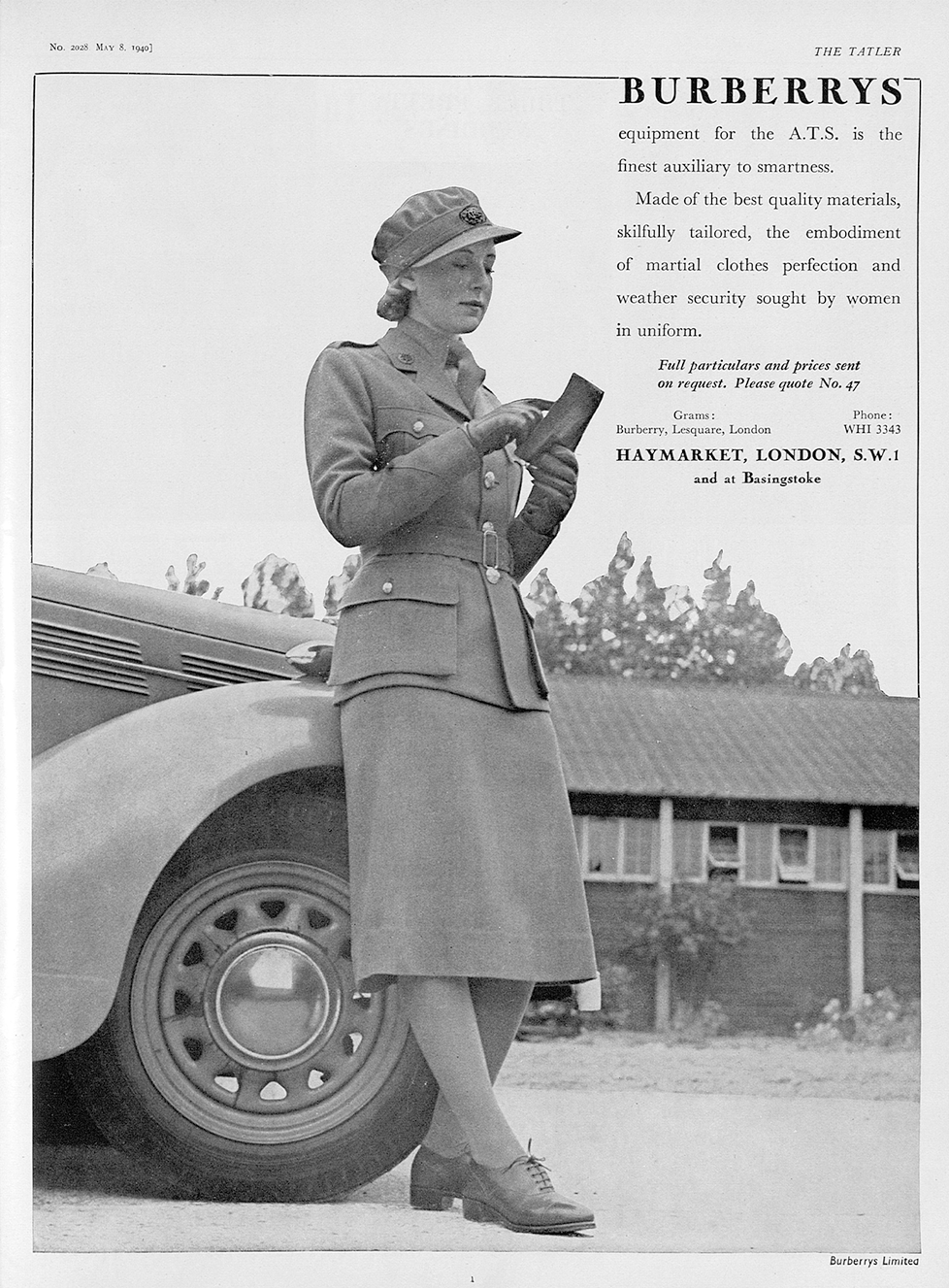 The Tatler, no. 2028, 8 May 1940, image 47.The Tatler and Bystander likewise highlighted the achievements of women during the war through their feature “It’s the Younger Generation, Work, Work, Working in the War”. This was published on 20 October 1943.
The Tatler, no. 2028, 8 May 1940, image 47.The Tatler and Bystander likewise highlighted the achievements of women during the war through their feature “It’s the Younger Generation, Work, Work, Working in the War”. This was published on 20 October 1943.
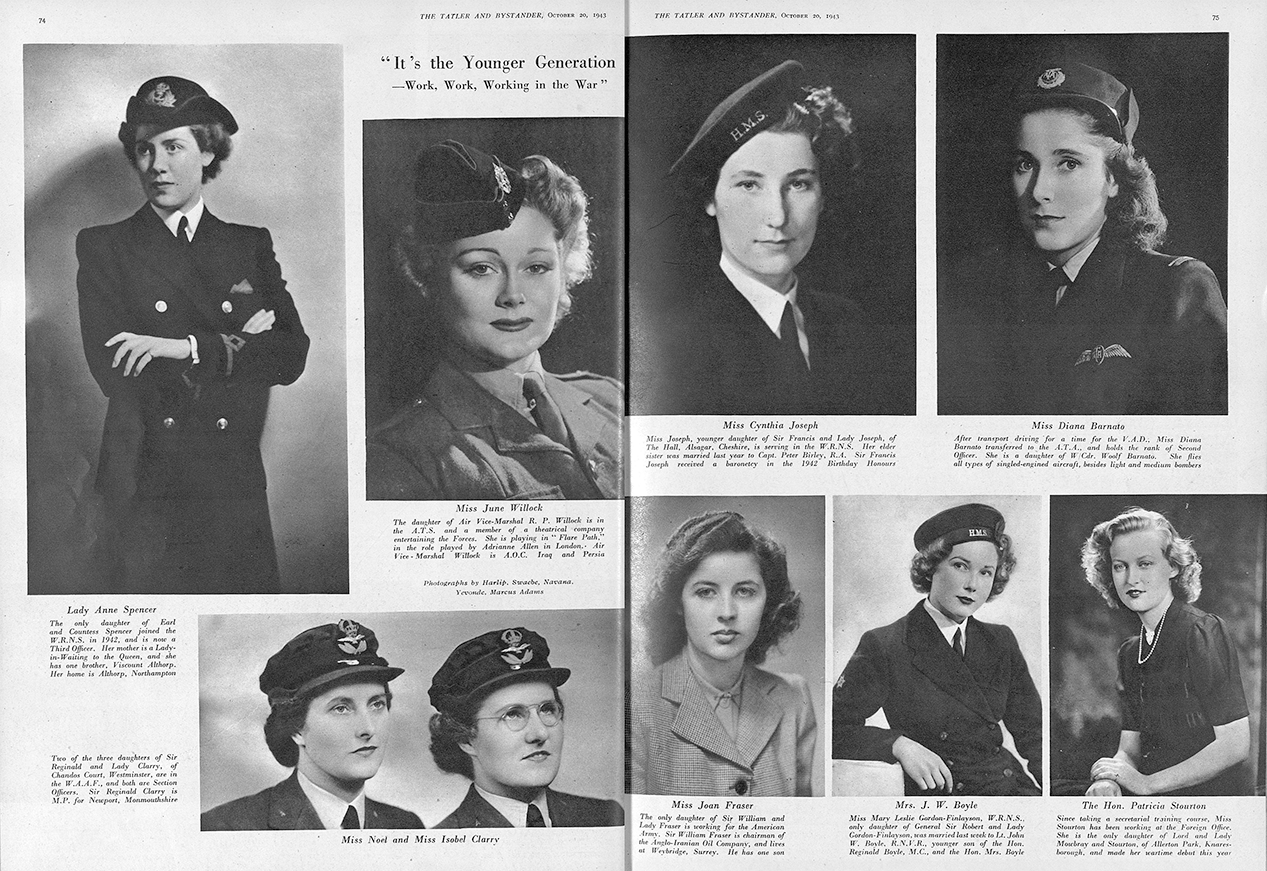 The Tatler, no. 2208, 20 October 1943, images 12–13.
The Tatler, no. 2208, 20 October 1943, images 12–13.
In this two-page feature, Miss June Willock is presented in a beautifully lit photograph, reminiscent of the film stars of the era. The caption flags her role in the ATS and the fact that she was a member of a theatrical company upon entering the forces—she had a role in the play Flare Path, written by Terence Rattigan in 1941 and first staged in 1942. Pictured in her uniform and cap, the author of the article points out that she is the daughter of Air Vice Marshall R. P. Willock.
Third Officer of the WRNS, Lady Anne Spencer—the only daughter of Earl and Countess Spencer of Althorp, and sister of the Viscount—strikes a defiant pose. Gazing to the left with folded arms, the picture conveys how her mind is made up to serve and succeed.
Miss Noel and Miss Isobel Clarry, Section Officers of the Women’s Auxiliary Air Force (WAAF), are pictured gazing upwards. They are the daughters of Sir Reginald and Lady Clarry of Chandos Court, Westminster. Their father is the MP for Newport Monmouthshire.
Miss Cynthia Joseph of the WRNS strikes a pose in her naval uniform and His Majesty’s Ship (HMS) cap. She is the daughter of Sir Francis and Lady Joseph of The Hall, Alsager. Notably, her father received a baronetcy in the 1942 birthday honours.
Miss Diana Barnato, Second Officer of the Air Transport Auxiliary (ATA), is featured in her uniform and cap, displaying her insignia and wings. Previously, she served as a transport driver for the Voluntary Aid Detachment (VAD). In the piece, Miss Barnato is lauded for her skill in piloting various single-engine aircrafts, as well as light and medium bombers.
The next portrait features Miss Joan Fraser in a smart civilian jacket and blouse. Her expression is direct and determined as she gazes into the camera. At the time, she was working for the US Army. Her father, Sir William Fraser, was the chairman of the Anglo-Iranian Oil Company.
Mrs J. W. Boyle of the WRNS is depicted in an optimistic pose, looking off to the left. Previously known as Miss Mary Leslie Gordon-Finlayson, she married Lt John W. Boyle of the Royal Naval Volunteer Reserve (RNVR) a week before this issue was published in 1943, thereby keeping naval service in the family.
Hon Patricia Stourton, pictured in an elegant dress and pearls, had worked as a civil servant for the Foreign Office. After completing her secretarial course, she made her wartime debut in 1943.
The photographs in this two-page spread were taken by Harlip, Swaebe, Navana, Yevonde, and Marcus Adams. They were all regular contributors to The Tatler and Bystander. Their carefully crafted photographs showcase key figures of the time.
When comparing the coverage from 1940 to 1943, there is a noticeable shift from more natural “on duty” shots to more glamourised and stylised studio portraits. The latter type of image aimed to entice and inspire, serving as a subtle form of propaganda designed to encourage continued loyalty and dedication to the overall war effort.
It is also worth highlighting how all of the women featured in the articles were from wealthy backgrounds, aligning with The Tatler and Bystander’s focus on the upper and upper middle classes and reflecting this publication’s overall readership.
Furthermore, it is important to note that while these women’s accomplishments in military and civil service are highlighted, they are always described in relation to their fathers, brothers, or husbands. This editorial approach framed their achievements within the context of the men around them. It therefore reinforced the significance of these women, but only within the bounds of a male-dominated, patriarchal society and class system.
During the Second World War, The Tatler and Bystander not only focused on women’s roles in the workplace and within the war effort, it also spotlighted women at play, as well as engaging in leisure and charitable activities.
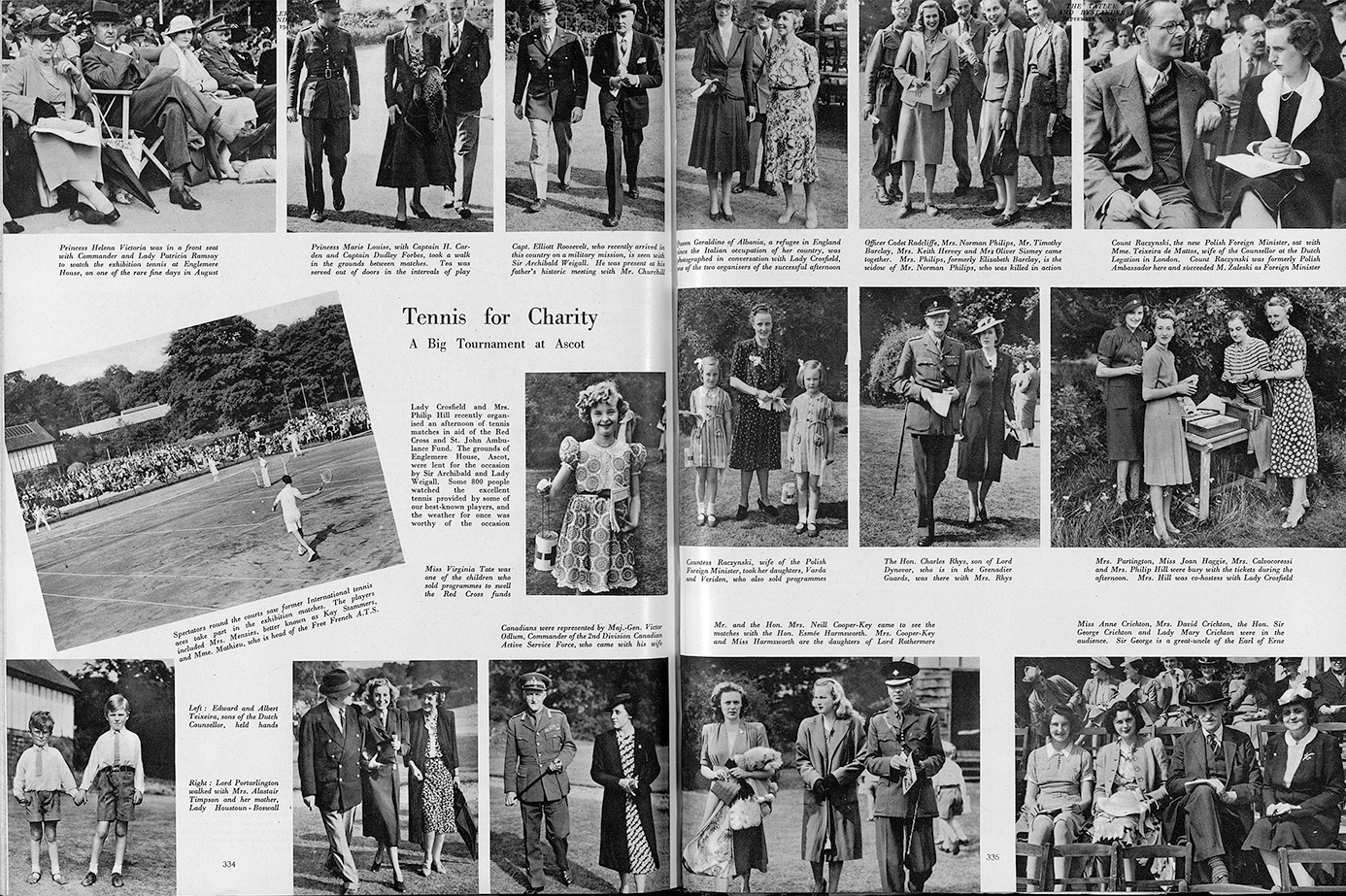 The Tatler, no. 2097, 3 September 1941, images 12-13.For example, a feature titled “Tennis for Charity: A Big Tournament”, published on 3 September 1941, showcased a charity tennis gathering where many women came together to raise funds for the Red Cross. The photographs spotlight the diverse range of international attendees, highlighting their outfits and connections. Among the notable guests were Princess Helena Victoria, Princess Marie Louise, and visitors from Albania, the Netherlands, and Poland. The gathering also included younger participants, such as Miss Virginia Tate, who sold programs to boost funds for the Red Cross.
The Tatler, no. 2097, 3 September 1941, images 12-13.For example, a feature titled “Tennis for Charity: A Big Tournament”, published on 3 September 1941, showcased a charity tennis gathering where many women came together to raise funds for the Red Cross. The photographs spotlight the diverse range of international attendees, highlighting their outfits and connections. Among the notable guests were Princess Helena Victoria, Princess Marie Louise, and visitors from Albania, the Netherlands, and Poland. The gathering also included younger participants, such as Miss Virginia Tate, who sold programs to boost funds for the Red Cross.
Another article, titled “On and Off Duty: A Wartime Chronicle of Town and Country”, published in The Tatler and Bystander on 28 April 1943, likewise offered a glimpse into the lives of notable individuals balancing leisure time and service during the war. The feature covered the engagement of Lady Sarah Spencer-Churchill and Lt Edwin F. Russell. It was accompanied by a studio portrait with one of her dogs. The piece also showcased the Andreae sisters—Janet, Bridget, Mary, and Elizabeth—posing for a studio portrait in their VAD uniforms and caps.
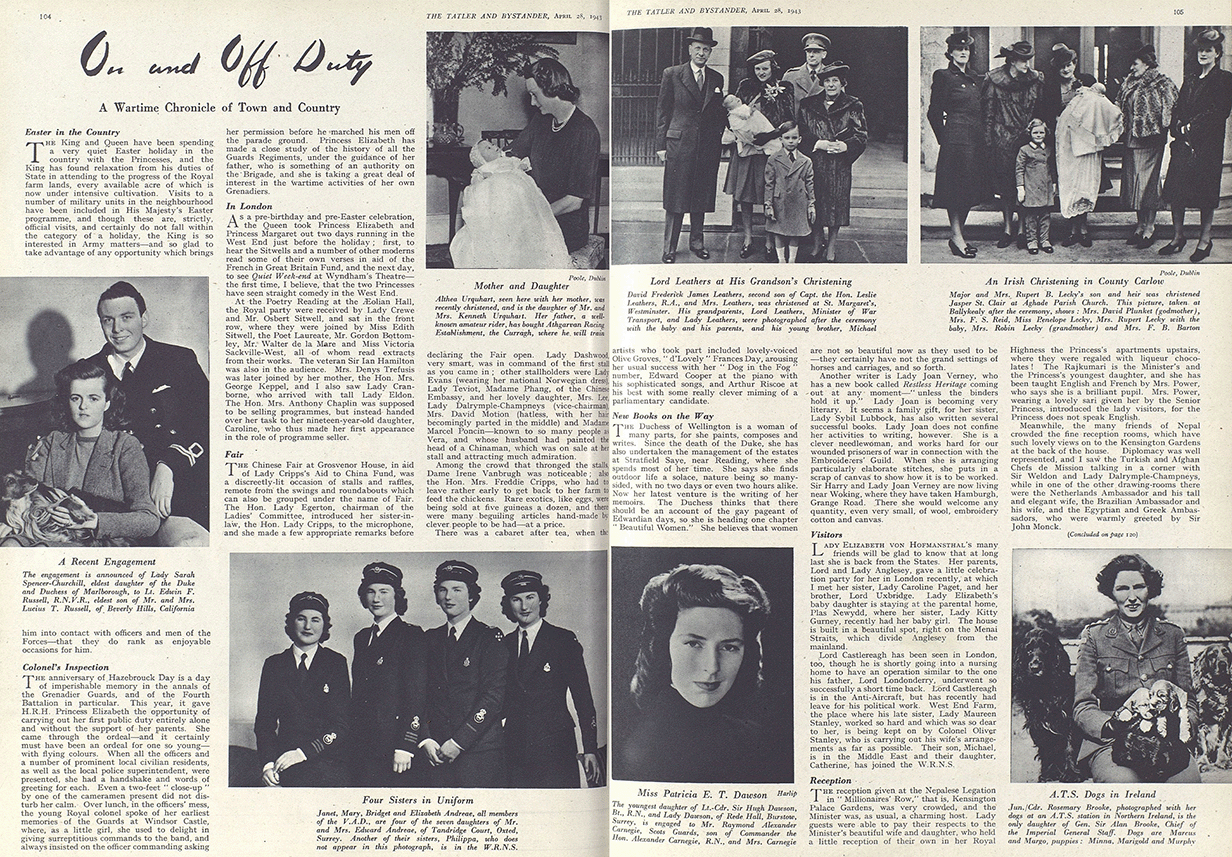 The Tatler, no. 2183, 28 April 1943, images 10-11.The article also included a portrait of Althea Urquhart with her mother during her christening in Dublin. Junior Commander Rosemary Brooke is pictured with ATS dogs in an outdoor portrait at her station in Northern Ireland. Another backlit studio portrait announced the engagement of Miss Patricia E. Dawson to Raymond Alexander Carnergie of the Scots Guards. The editorial maintained a light, jolly tone while reporting on the mix of social events and appearances alongside military service. The piece kept a good balance between “on and off duty” matters and emphasised how leisure time was an important aspect of life during wartime.
The Tatler, no. 2183, 28 April 1943, images 10-11.The article also included a portrait of Althea Urquhart with her mother during her christening in Dublin. Junior Commander Rosemary Brooke is pictured with ATS dogs in an outdoor portrait at her station in Northern Ireland. Another backlit studio portrait announced the engagement of Miss Patricia E. Dawson to Raymond Alexander Carnergie of the Scots Guards. The editorial maintained a light, jolly tone while reporting on the mix of social events and appearances alongside military service. The piece kept a good balance between “on and off duty” matters and emphasised how leisure time was an important aspect of life during wartime.
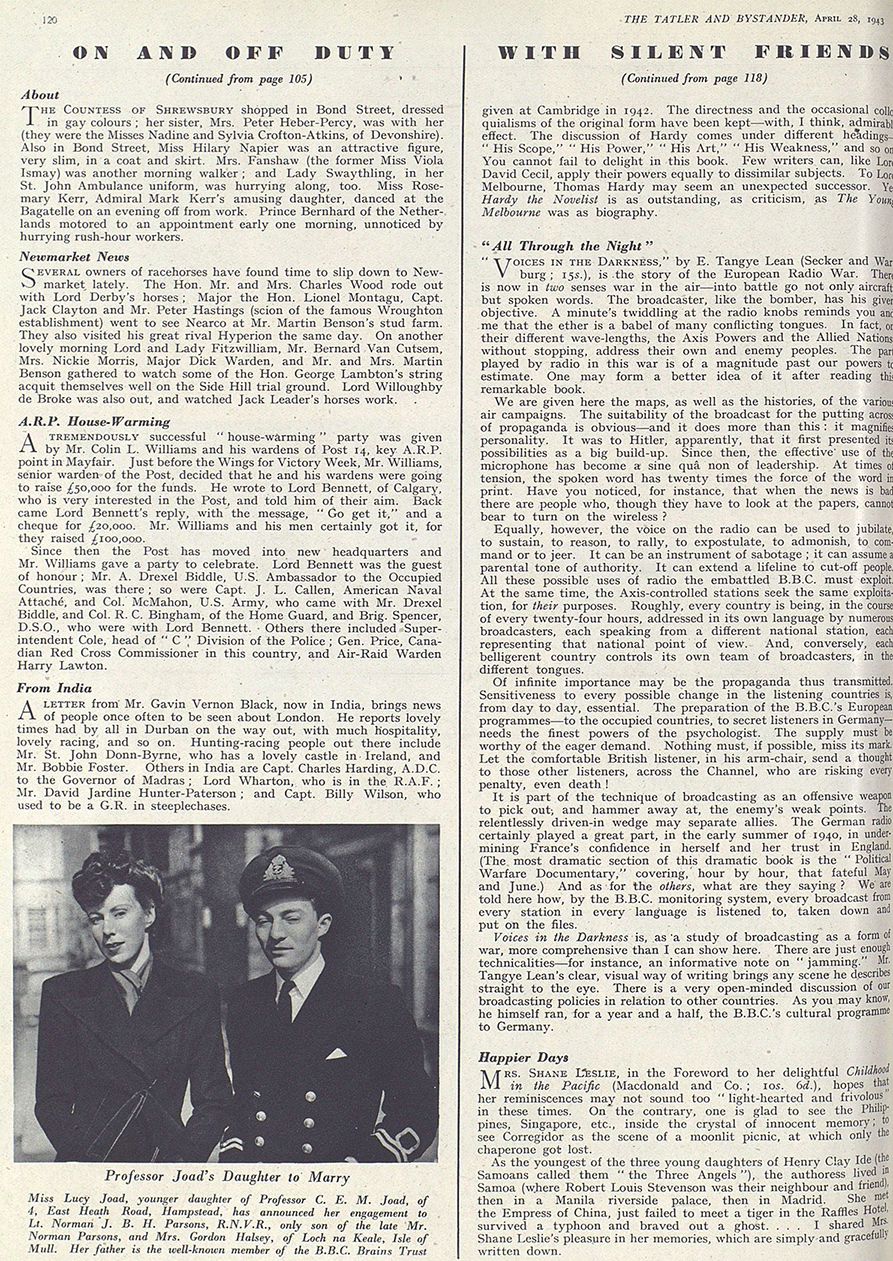 The Tatler, no. 2183, 28 April 1943, image 26.
The Tatler, no. 2183, 28 April 1943, image 26.Royal duties were a conspicuous feature of popular journalism during the war. For example, in a piece titled “Pigeon Post”, published on 3 March 1943, Princess Elizabeth and Princess Margaret were pictured in their Guides uniforms whilst sending a “Thinking Day” message to Lady Baden Powell by Pigeon Post. The message relayed “greetings and good wishes from my sister and myself, with pride and thankfulness that Guides everywhere are taking their part in the great fight against evil”. Unsurprisingly, the princesses were frequently utilised for propaganda and morale-boosting purposes. Their message to Lady Powell was no doubt carefully orchestrated so as to inspire Guides and young people across the Allied nations and the Commonwealth.
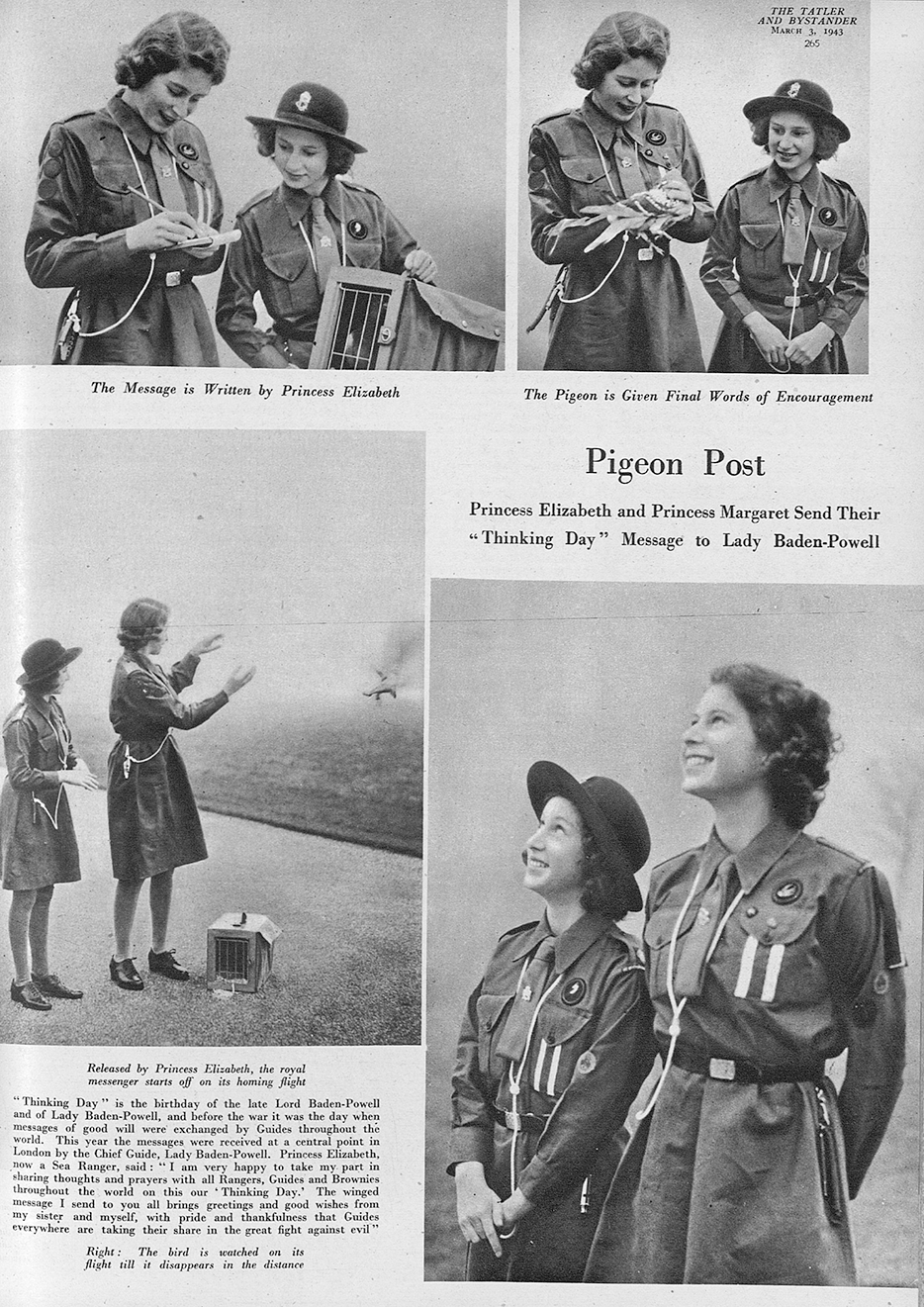 The Tatler, no. 2175, 3 March 1943, image 11.
The Tatler, no. 2175, 3 March 1943, image 11.Princess Elizabeth trained and served as a motor mechanic and driver with the ATS. This was highlighted on the front cover of The Sketch on 18 April 1945, where she was pictured alongside her ATS colleagues.
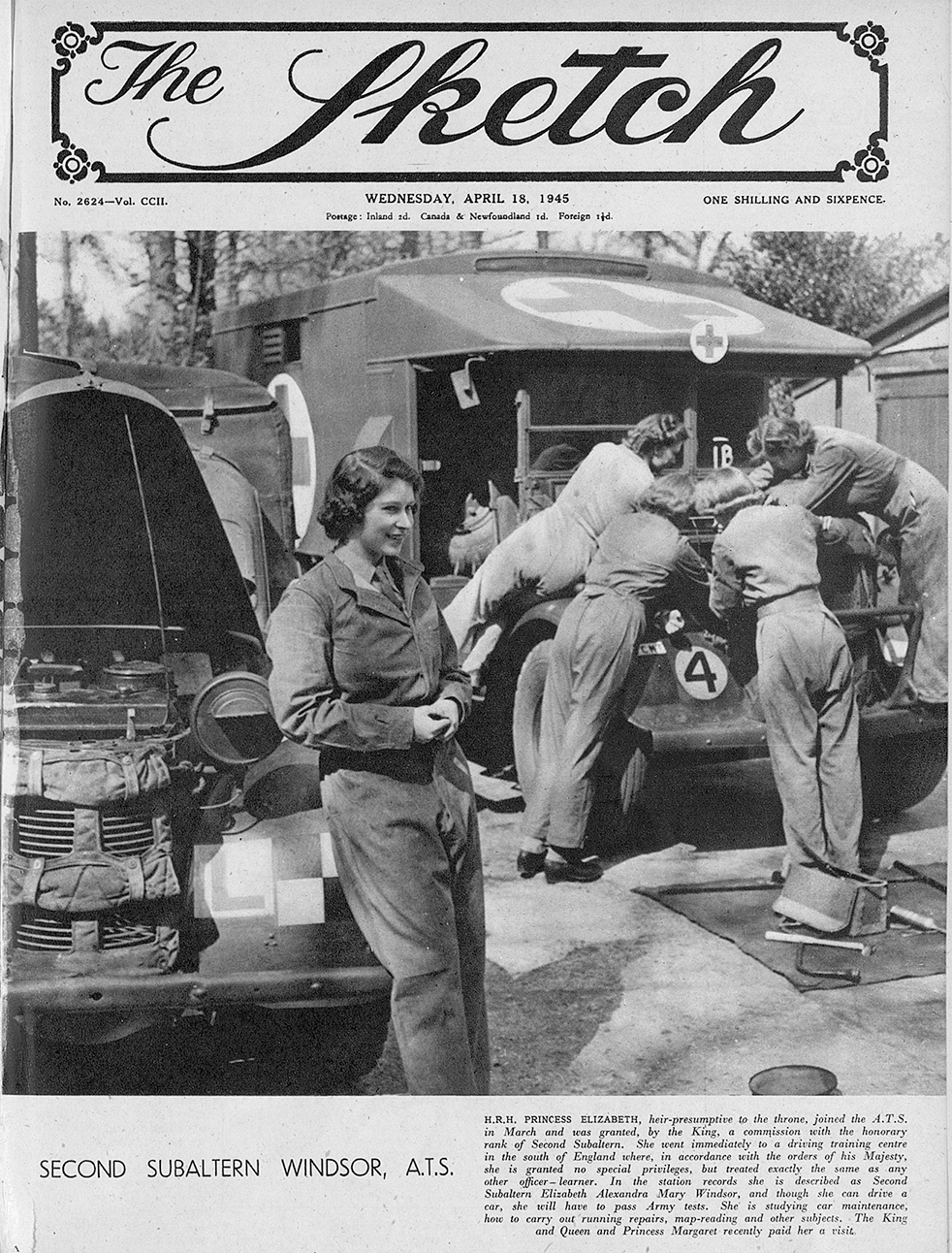 The Sketch, no. 2624, 18 April 1945, image 1.
The Sketch, no. 2624, 18 April 1945, image 1.In a studio portrait by female photographer Dorothy Wilding, Princess Elizabeth appears in her new ATS uniform on the cover of The Tatler and Bystander (25 July 1945). This poised and confident image is the epitome of high status. These early endeavors significantly influenced her future path, shaping her life of service as Princess Elizabeth and later as Queen Elizabeth II.
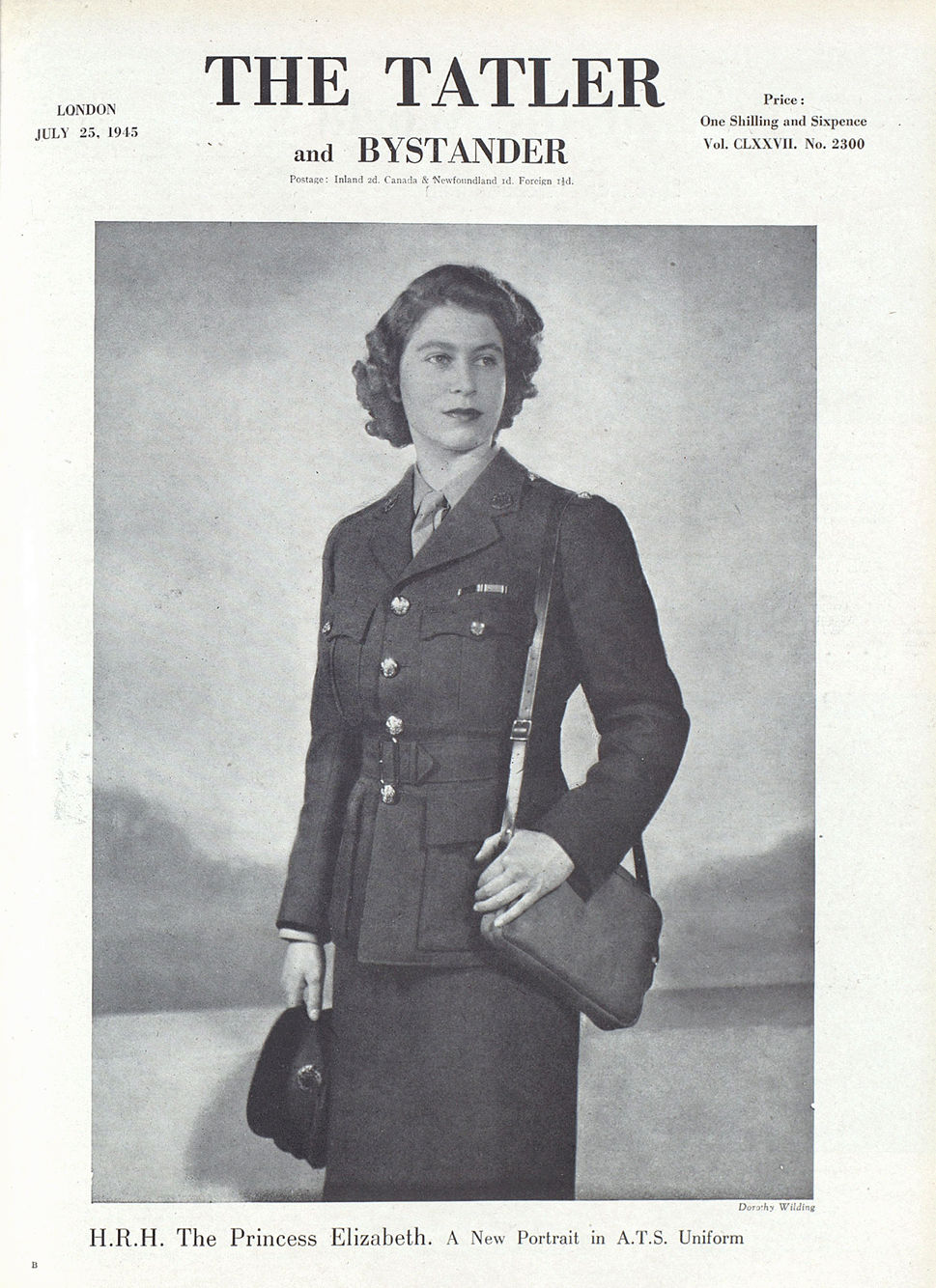 The Tatler and Bystander, no. 2300, 25 July 1945, image 3.
The Tatler and Bystander, no. 2300, 25 July 1945, image 3.Times change and stories never stay the same. "Tales from The Tatler" takes a look at the people and places that were featured in this publication, as well as in its sister titles, such as The Sketch. If you would like to explore these publications in more detail, you can browse issues of The Tatler, as well as the back catalogues of eight other periodicals owned by the Illustrated London News, at British Online Archives.
